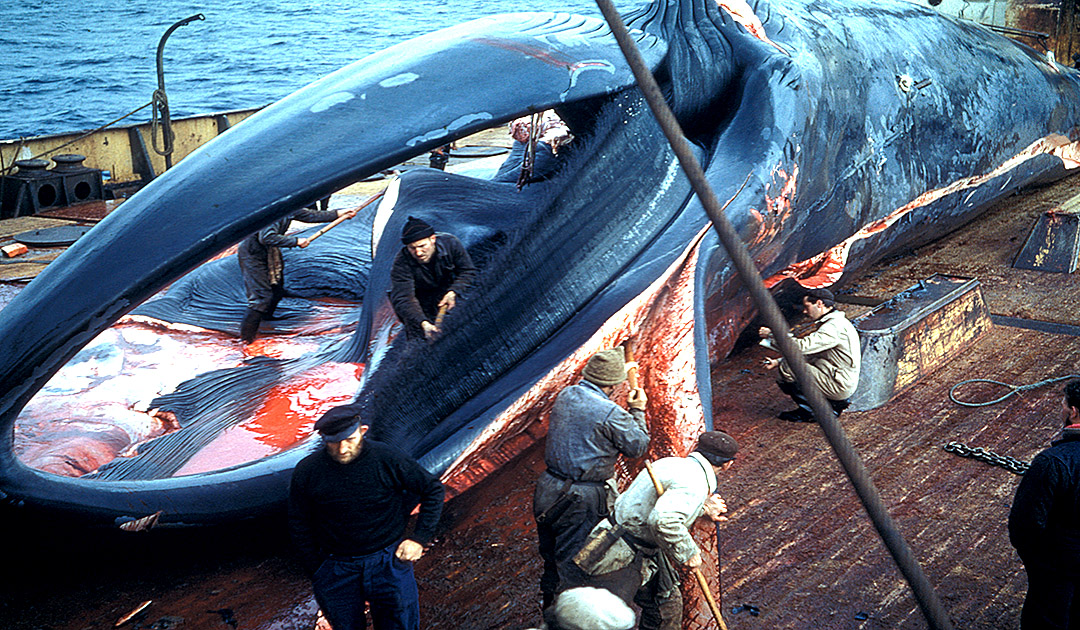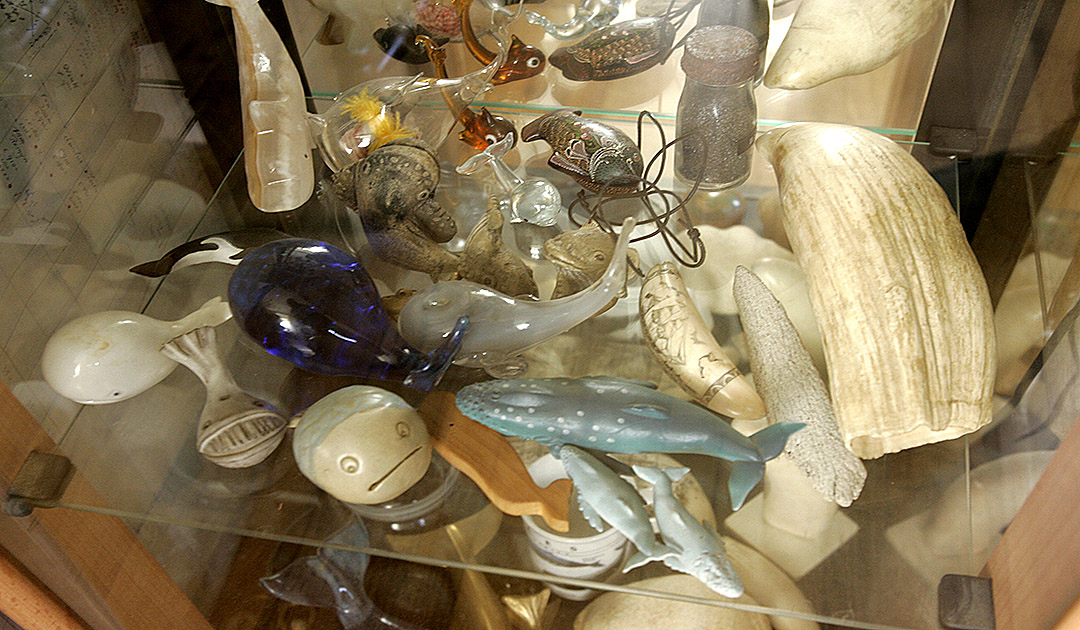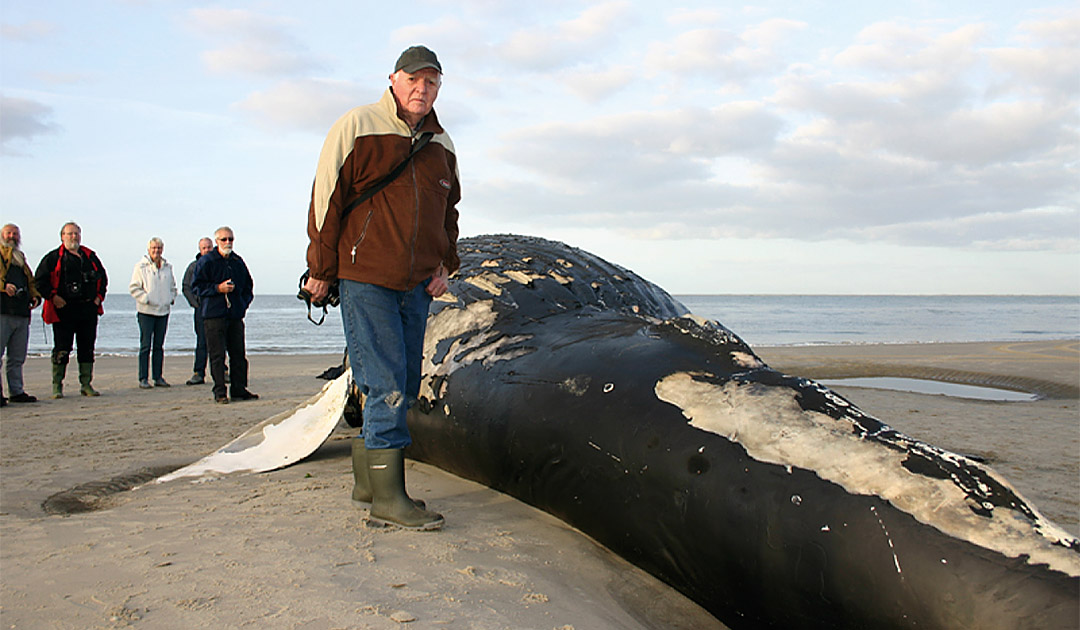
We always want to pick up exciting stories for our readers. We are not always able to report on pleasant things, such as the story about whaling in the last century. After a long discussion in the editorial team, Christian Hug and Heiner Kubny paid a visit to the former whaler Cornelius Gransbergen a few years ago. Curious and shocked, we listened to his story for four days. We deliberately want to make people aware of the fact that whales are still being hunted today. But we do not want to condemn whalers from the 1950s and the following years.

Ameland is a beautiful spot. A small North Sea island in West Friesland, at the very top of Holland, 27 kilometers long and a few kilometers wide. There’s room enough for four villages that look like overgrown model railroad settlements: tiny brown brick houses with tiny red cobblestone streets and tiny green gardens. The salty sea wind blows sometimes stronger, sometimes weaker over the dunes, but permanently. High and low tide determine the rhythm of the Wadden Sea, where thousands and thousands of birds breed in summer. In short: Ameland is idyllic. And so quiet that there is almost nothing to do on the island when the ferry is not bringing tourists. Except going to sea and catching fish, herring for pickling and plaice for frying. But they are only small fish even in the proverbial sense. From the time of the really big lumps that once brought fame and glory, there is only what is now called history on Ameland: the 400-year-old dwellings of former captains of whaling ships. The whaling museum in Ballum, garden fences made of long-weathered whale bones. And Cornelius Cransbergen.

Confidence in the theory
Cor, as he was called by the islanders, worked for ten seasons in the fifties and sixties on the ships of the Dutch whaling fleet, hunting the giant marine mammals in the waters of Antarctica. At that time, his work earned him great prestige, a lot of money and the blessing of scientists. Until his death, Cor was a Greenpeace member like most of his former professional colleagues, working to protect his former prey. “It is a disgrace to all mankind that these wonderful animals are still hunted today,” Cor railed, “simply a disgrace. There is no reason to hunt whales today.”
Cor had strong, steady hands, bushy eyebrows with deep-set dark eyes. He was tall and still of impressive stature. He lived with his wife, Hennie, in one of those tiny Ameland cottages and kept half a dozen long-haired dachshunds. When he went to the dunes or to check on the cottages he rented to tourists, he put on a green wax jacket. And when he told about the great whales, how they were becoming fewer and fewer and had to give up their lives for nothing, his eyes began to sparkle wildly and angrily.
Cor from Nes, angry? When he himself had contributed to the desolate situation of the whales as a ship’s cook on a whaler? Cor did not shy away from this question. “Scientists at the time credibly calculated for us in blue whale units: Two fin whales or three humpback whales corresponded to one blue whale unit. One could safely hunt 16,000 blue whale units per year worldwide, because the total population of large whales grows by 20,000 blue whale units annually, which still results in an annual increase of 4,000 blue whale units. So we set sail with the academically secured knowledge not to decimate the whale population in any way. There were clear regulations, how large a whale had to be in the minimum, that it could be shot. Captains who did not comply with the regulations were still reprimanded in the daily newspapers at that time. And on our ship, there were always several scientists on board who accurately measured each whale caught. A blue whale, for example, had to be at least 66 feet long. At least with us.” That wasn’t the case with others, he said. “Russian whalers told me they shot at anything that moved…”

Whaling tradition
So the question of conscience was settled before it was asked. But that was only one of the reasons Cor signed on as a whaler. The other was Ameland. “There was no work here, especially since our country was still suffering from the bad effects of World War II,” Cor says. “When my father had to give up his bakery because of polio, I was too young to take over his business.” Cor went to sea. First on a small coastal trading ship to London, Manchester and Paris, “but that was endlessly boring.” He sensed his chance when a sailor offered him a job on the whaling ship “Willem Barendsz,” the only mother ship in the Dutch whaling fleet.
Ameland has always been a whaling island. For centuries, Amelanders set sail in pursuit of whales. Many lost their lives in the process, and captains like Hidde Dirk Kat achieved fame, but all earned good money and great prestige among the islanders with this trade. Whalers were wild guys. Cor wanted to try his luck as well. And whales were useful animals in those days: they were used to make candle and machine oil, margarine and meat, ivory and paints, soaps, ointments and soups… Even after World War I, British army leaders said, “Without whale oil, the government would not have been able to fight both the food battle and the munitions battle.”

On the “Willem Barendsz”
In the fall of 1951, Cor, then 23 years old, boarded the “Willem Barendsz” in Amsterdam. “In Amsterdam, we loaded 15,000 kilos of ammunition before setting sail for Curaçao to refuel,” Cor recounts. The journey took two weeks there, and the “Willem Barendsz” was underway for another three weeks to Cape Town. “During that time there wasn’t much for us to do, tie man-thick ropes and lay out the deck with wooden planks.” Cor would soon see what the double bottom was useful for.
In Cape Town, the ship was anchored while the fishing boats set in the local harbor were cleared: up to 18 smaller steamers, each with a crew of 15, which sailed ahead of the mother ship and hunted down the whales. To reinforce the crew, about 350 South Africans came on board, so that the total crew numbered about 1100 men. After three or four days in Cape Town, the “Willem Barendsz” set sail again, this time for Antarctica. The voyage there lasted one week.
Cor worked on the mother ship as a “hook boy”: with the crooked knife on the long handle, he cut the blubber from the whales’ flesh. The whales brought in from a collection boat were pulled onto the blubber deck and cut up. In thick chunks of more than ten kilos, the blubber went directly into the oven, where it melted into tran and was put into barrels. “It was exhausting and dangerous work,” said Cor. “After all, the ship was constantly rocking. If you were hit by a falling piece of blubber weighing several tons, you could easily be beaten to death.” There were one or two deaths on the ship each season, he said.

The deck was so slippery from the fat and blood that the workers hammered nails into their shoes to avoid slipping – the wooden boards with which the deck was lined gave them a secure grip. The spitted whale was pulled forward by winches to the meat deck, where other “hook boys” cut the meat from its bones and deep-froze it in the ship’s belly. There were always a few Japanese on board the “Willem Barendsz” who bought the best cuts of meat from the square and ordered Japanese ships to come and collect the meat. “The Japanese,” says Cor, “were always very good sailors, by the way.” The bones were pounded into meal. The rest, the offal, was swiftly thrown overboard – because the next whale was literally already approaching. This went on 24 hours a day in multiple shifts.

From the deck to the galley
“After a few months, I was ordered to the kitchen. One of the cooks was sick, and because the chef knew I had learned to be a baker, he ordered me to join him.” So Cor became a cook, “but in the big galley I was treated like a bumpkin because I came from a small island and not from the big cities of Amsterdam or Rotterdam like most others.” For six months, Cor cruised the Antarctic waters on the mother ship before the “Willem Barendsz” docked back in Cape Town. Supplies of fruits and vegetables had long since run out, and the eggs they carried had been smelling rotten for weeks. “After so long at sea, the city felt like the land flowing with milk and honey,” Cor enthused. But still: 1626 blue, fin, humpback and sperm whales had been caught by the fleet and processed on the mother ship. Now, it was time for the whole trip back: getting the catching ships ready for the summer and back to Amsterdam, and from there back home to Ameland. Nine months in total he was away. And back to the “Willem Barendsz” Cor did not want in any case. “I told my boss that I would only come back next season if I could cook on a fishing vessel.”
No problem: three months later, Cor boarded the “Willem Barendsz” again, sailed to Cape Town and became the cook of a fishing vessel. The fishing ships sailed one to two days ahead of the mother ship in search of whales. If the scout on the lookout had sighted the white fountains of the sea giants, he guided the boat in the direction of the whales. If the ship was close enough, the captain would go from the bridge to the bow via a direct gangplank, because it was exclusively up to him to fire the cannon harpoon. The scout in the lookout now guided both the ship and the captain: from the lookout he could best estimate when the ideal moment came for the gunner to fire his fatal shot.
With a loud bang, the captain fired the cannon harpoon. The projectile bored into the whale’s body and detonated inside it. “A good shooter only needed one shot per whale” said Cor. “But I’ve seen captains who had to shoot five times before the whale was dead.” The dead animal was pulled with ropes and hooks to the planks, where air was pumped into its body with hoses to keep it from sinking. The radio operator reported the catch to the collection ship, and the whale was marked with a flag and a radar reflector. And on went the journey through the icy waters in search of the next victim. Uninterrupted day and night, for six months.
Cor meanwhile cooked for his men, provisions from the mother ship. And, of course, whale meat. “Fried, it tastes like beef steak. But you have to eat it while it’s warm, or it gets a musty taste.” He served fresh bread and sweet cakes to his men, that was due his baker’s honor.

A rich man
Back home in Ameland, Cor could count money. A lot of money, because he earned more on a catching ship than on the mother ship. He was paid a fixed salary and a commission for each whale he killed, graded according to his rank. For him, the cook, 7.69 cents plus as much “hunter’s bonus” per 180-liter barrel of tran, 10.38 cents per ton of bone meal, 14.43 cents for each liver. Thus he came in the eight-month hunting season 58/59 with 219 killed whales on a wage of 6’016.08 Dutch guilders. Which according to today’s calculation is 2,750 euros, a lot of money for the time. That equals 752 guilders per month – plus, if you will, room and board. An astronomically high sum. Cor: “During the months at home, I worked on the ferry. There I earned just 240 guilders a month, or a third of the whaler’s wages.” If you add the wages of this season to 1100 crew members and the operating costs for the largest whaling mother ship in the world at that time and their catching ships with a total hunting yield of 2190 whales, you can calculate how lucrative whaling was at that time.

Soon he had the money for his first house. He rented it out to tourists and made even more money. “After ten whaling seasons, he owned ten vacation cottages on Ameland,” Cor told me proudly, his chest swelling a little. An investment that had become his retirement provision until his death.

Years later it became more and more obvious that the blue whale unit theory of the scientists was a lie. The whales became less and less. The big hunt was no longer profitable, neither for the whalers nor for the state. And more and more whale products could now be produced without whales. In 1963 Cor got out. In the meantime he had a secure income with his vacation cottages. One year later Holland stopped whaling. In 1966 the “Willem Barendsz” was sold, first to South Africa, where it was converted into a floating fishmeal factory, and in 1973 the South Africans sold the ship to the Koreans.
“I didn’t feel guilty that whales were in danger of extinction today,” Cor said. “Things were different then. But I’m pissed off at countries like Japan and Norway that still hunt whales today on flimsy reasons.” In 2003, Cor traveled to Antarctica again with Hennie on a cruise ship. “In areas where we used to sight hundreds of whales, I only saw two white fountains on the cruise.”

Cor Gransbergen has started his last journey
He died peacefully on January 30, 2021 at the age of 92. Cor was full of stories and loved to tell them. If there was something to do about whaling, a humpback whale stranding, an exhibition or a lecture, Cor Gransbergen was there.
By Christian Hug (Text)
and Heiner Kubny (image processing)






I think it’s too much to state that the scientists were lying, in general. Many of them saw overfishing happening and warned for it. But whaling company directors and managers ignored these warnings. The Blue Whale Unit (BWU), first introduced in the early 1930s at the highlight of whaling in the Southern Ocean, failed to take into the account the species taken. After Blue Whales were commercially extinct, more of the smaller species had to be taken to achieve the equivalent of 16.000 Blue Whales set by the International Whaling Commission (IWC) for the 1946-1947 season, when The Netherlands started whaling. Note that The Netherlands started whaling at a time when whales had already become relatively scarce. For the 1955-1956 season, IWC dropped the BWU to 15.000 units, and two years later to 14.500. The Netherland (and Japan) voted against these BWU reductions. So it’s not so much the scientist but the (Dutch) IWC members who are to blame. The Netherlands left the IWC, causing the overall quota management to become ineffective, resulting in 20% more whales being killed than the recommended BWUs. So rather than blaming the scientist, I think it’s fair to blame the whaling representatives in the IWC. “To the greed and folly of mankind”, as British scientist F. D. Ommanney (1903-1980) coined in 1971, after the whaling industry had come to a halt.